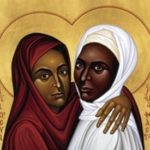Last Updated on February 21, 2024 by Kittredge Cherry
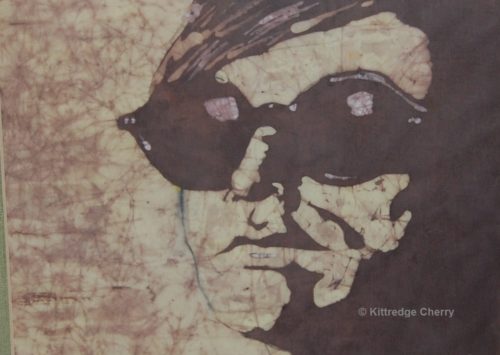
Pop artist Andy Warhol kept his homosexuality hidden and his Christian faith even more secret. The truth is coming out since his death on Feb. 22, 1987.
Warhol is famous for painting Campbell’s soup cans, but he made hundreds of other works, including avant-garde films and religious-themed art. Even his secular art is influenced by his lifelong Byzantine Catholicism.
He was also an astute social observer who accurately predicted, “In the future, everyone will be world-famous for 15 minutes.”
The Vatican planned a major exhibit of Warhol’s religious work for 2019, then canceled or postponed it indefinitely. It was going to showcase his variations on Da Vinci’s Last Supper and his skull paintings inspired by “memento mori” Renaissance art. A joint exhibit of Warhol’s spiritual art is on display at the Brooklyn Museum in New York through June 19, 2022. Titled “Andy Warhol: Revelation,” it is the first exhibition to comprehensively examine the Pop artist’s complex Catholic faith in relation to his art. It was also shown at the Warhol Museum in Pittsburgh, Pennsylvania.
“Christian motifs frequently appear in both explicit and metaphorical forms throughout the body of Andy Warhol’s oeuvre. While his monumental crosses and depictions of Christ directly reference biblical stories, this exhibition will also explore his coded depictions of spirituality such as an unfinished film reel depicting the setting sun, originally commissioned by the de Menil family and funded by the Roman Catholic Church,” says the official description at the museum website.
My personal connection with Andy Warhol
I adored Andy Warhol when I was a teenager in Iowa in the early 1970s. His mysterious persona and ambiguous sexuality gave me a rare and much-needed connection to queer culture. The queerest thing in my high school’s library was probably the biography of Andy Warhol, and I spent many lunch hours there reading it.
I wore out my cassette tape listening over and over to androgynous glam-rock star David Bowie sing about Warhol on his Hunky Dory album. I special-ordered Warhol’s book “a: A Novel,” which was a transcript gay and counterculture eccentrics talking at his New York studio, known as the Factory. One year I celebrated his Aug. 6 birthday by mailing out anonymous letters — envelopes filled with my own Warhol-inspired artwork.
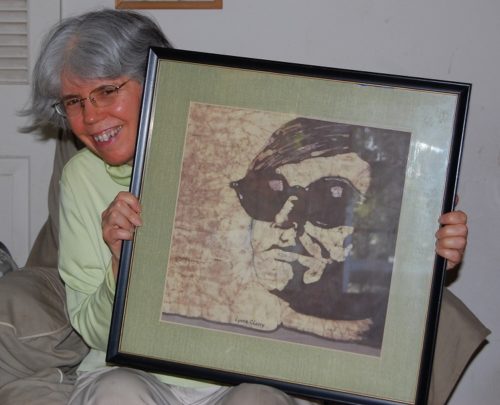
Q Spirit founder Kittredge Cherry holds the batik portrait of Andy Warhol that she created during her high-school years.
When I was in high school, I even created my own batik portrait of Warhol — the image at the top of this post. I can honestly say that Warhol helped me get through some tough teenage years. When I entered seminary, I thought I left Andy Warhol behind, so it is a joy to discover his religious faith.
Religion in Andy Warhol’s life and art
Warhol was born on Aug. 6, 1928 in Pittsburgh to a devout Byzantine Catholic (or Ruthenian) family of immigrants from Slovakia. He was raised in the Ruthenian church, an Eastern Catholic rite which is in full communion with Rome. He studied commercial art at Pittsburgh’s Carnegie Mellon University and moved to New York City to launch his successful career as an artist.
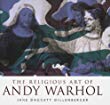 Religion was important in Andy Warhol’s life and work. This is documented in the book “The Religious Art of Andy Warhol” by Jane Daggett Dillenberger. In addition to his Last Supper series, his art with overtly religious content includes a series of cross paintings. In his 1984 series “Details of Renaissance Paintings,” he reworks such famous religious paintings as DaVinci’s Annunciation, Paolo Uccello’s St. George and the Dragon, and Raphael’s Sistine Madonna.
Religion was important in Andy Warhol’s life and work. This is documented in the book “The Religious Art of Andy Warhol” by Jane Daggett Dillenberger. In addition to his Last Supper series, his art with overtly religious content includes a series of cross paintings. In his 1984 series “Details of Renaissance Paintings,” he reworks such famous religious paintings as DaVinci’s Annunciation, Paolo Uccello’s St. George and the Dragon, and Raphael’s Sistine Madonna.
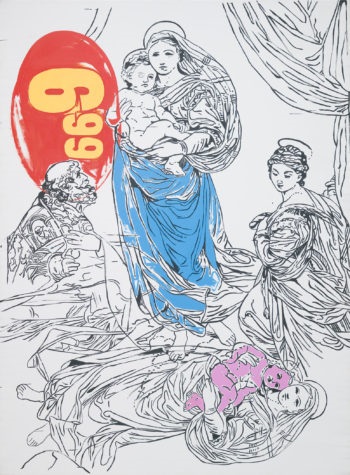
“Raphael Madonna-$6.99” by Andy Warhol, 1985, The Andy Warhol Museum, Pittsburgh, © The Andy Warhol Foundation for the Visual Arts, Inc. This image appeared on the mass card for his memorial service.
Queer and Christian subtexts are hidden even in his seemingly secular art. For example, he drew from gay underground culture’s fascination with certain glamorous women when he did his famous portraits of Marilyn Monroe, Elizabeth Taylor, Judy Garland and other celebrities. He depicted their faces in a flat style that echoes the grid of icons at the church where he grew up (St. John Chrysostom Byzantine Catholic Church in Pittsburgh). The red and white of Warhol’s famous soup cans may symbolize the body and blood of Christ. Campbell’s soup is sort of the “lifeblood” of Middle American consumer culture.
 Warhol’s queerness is examined in the book “Pop Out: Queer Warhol” by Jennifer Doyle, Jonathan Flatley, and José Esteban Muñoz (editors).
Warhol’s queerness is examined in the book “Pop Out: Queer Warhol” by Jennifer Doyle, Jonathan Flatley, and José Esteban Muñoz (editors).
Warhol was evasive about his sexual orientation and activity. He was seen as a virgin or voyeur. But after his death a variety of male lovers declared themselves and affirmed his gay identity. Details of his secret piety also came out. The final image that he created was a Last Supper.
Andy Warhol’s religious life
Warhol’s religious life is summarized this way in the official online description of the exhibit “Andy Warhol: Revelation”:
“Born in Pittsburgh to a devout Byzantine Catholic family, Warhol grew up attending multiple weekly services at his local church with his mother, Julia Warhola. He would stare for hours at the icon paintings of Christ and the saints that hung in the elaborate iconostasis, or icon screen, at the front of the nave. In the Warhola family’s Carpatho-Rusyn neighborhood, life revolved around the church community, and the young artist was deeply impacted from this environment…. Throughout his life as a celebrity artist, Warhol retained some of his Catholic practices when his peers were distancing themselves from their religious backgrounds. Yet, his relationship with Catholicism was far from simple. As a queer man, Warhol may have felt a sense of guilt and fear towards the Catholic Church, which kept him from fully immersing himself in the faith. Nevertheless, he used various media to explore this tension through his art.”
Wikipedia tells more about the role of religion in Warhol’s life:
Warhol was a practicing Ruthenian Catholic. He regularly volunteered at homeless shelters in New York City, particularly during the busier times of the year, and described himself as a religious person…. During his life, Warhol regularly attended Liturgy, and the priest at Warhol’s church, Saint Vincent Ferrer, said that the artist went there almost daily… Warhol’s brother has described the artist as “really religious, but he didn’t want people to know about that because [it was] private/” Despite the private nature of his faith, in Warhol’s eulogy John Richardson depicted it as devout: “To my certain knowledge, he was responsible for at least one conversion. He took considerable pride in financing his nephew’s studies for the priesthood.”
The Catholic Herald adds more info in “Andy Warhol’s devotion was almost surreal,” a 2018 article by Michael Warren Davis:
He lived with his mother until she died, and every morning they would pray together in Old Slavonic before he left for the Factory. He always carried a rosary and a small missal in his pocket.
Aleteia tells vivid details:
Beside his bed, Warhol placed a handmade plaster-of-paris shrine, with a crucifix and a worn prayer book on his bedside table. Under his white shirt, he wore a cross on a chain around his neck; and in his pocket, he carried a rosary. Andy Warhol’s Catholicism was evident in his philanthropy as well as his personal piety. He was a generous supporter of several organizations including a soup kitchen operated by the Church of the Heavenly Rest, an Episcopal church on E. 90th Street.
He made a pilgrimage to the Vatican in 1980. The startling photo of his meeting with Pope John Paul II. can be seen at “Andy Warhol goes to the Vatican.”
In 1968 Warhol survived a gunshot wound from a murder attempt by radical lesbian feminist Valerie Solanas. Her story is told in the 1996 film “I Shot Andy Warhol” starring Lili Taylor.
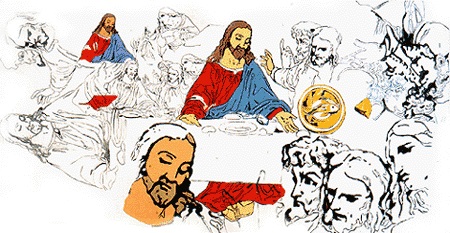
Images of Jesus from The Last Supper cycle by Andy Warhol (Wikipedia)
In the last year of his life, Warhol reportedly became obsessed with Leonardo Da Vinci’s Last Supper, producing more than 100 works based on it, some up to 40 feet in length. They were first exhibited one month before he died.
Warhol died on Feb. 22, 1987 at age 58 in a Manhattan hospital following gallbladder surgery. His funeral took place shortly after his death at Holy Ghost Byzantine Catholic Church in Pittsburgh, followed on April 1 by a memorial mass attended by 3,000 people at Saint Patrick’s Cathedral in New York City. The scripture for the mass was Wisdom 3:1-9, including these lines:
But the souls of the righteous are in the hand of God,
and no torment will ever touch them.
In the eyes of the foolish they seemed to have died,
and their departure was thought to be a disaster,
and their going from us to be their destruction;
but they are at peace.
Warhol is buried with his parents at Saint John the Baptist Byzantine Catholic Cemetery on the outskirts of Pittsburgh. In the spirit of his life and work, Warhol’s grave can be viewed 24 hours a day in a webcam live feed called “Figment.”
Controversial gay artist Robert Mapplethorpe used Christian imagery to create a photographic portrait of Warhol, who was a personal friend. He gave Warhol a halo and positioned his face inside a cruciform frame.
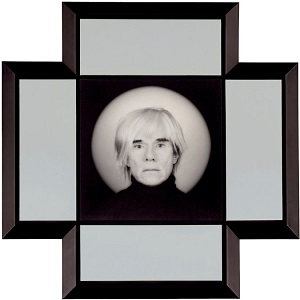
Andy Warhol by Robert Mapplethorpe © Robert Mapplethorpe Foundation
___
Related links:
Andy Warhol Museum
How Andy Warhol’s childhood church anchored his faith and his art (CarnegieMuseums.org)
___
Top image credit:
Andy Warhol batik by Kittredge Cherry, Q Spirit founder
This post is part of the LGBTQ Saints series by Kittredge Cherry. Traditional and alternative saints, people in the Bible, LGBT and queer martyrs, authors, theologians, religious leaders, artists, deities and other figures of special interest to lesbian, gay, bisexual and transgender and queer (LGBTQ) people and our allies are covered.
This article was originally published on Q Spirit in February 2019, was expanded with new material over time, and was most recently updated on Feb. 22, 2023.
Copyright © Kittredge Cherry. All rights reserved.
Qspirit.net presents the Jesus in Love Blog on LGBTQ spirituality.



















